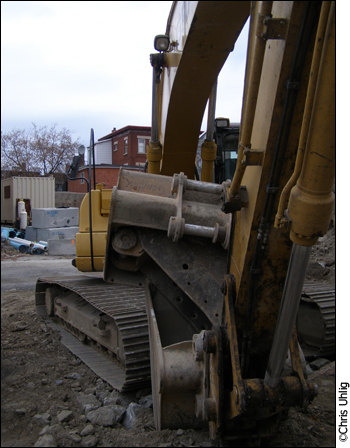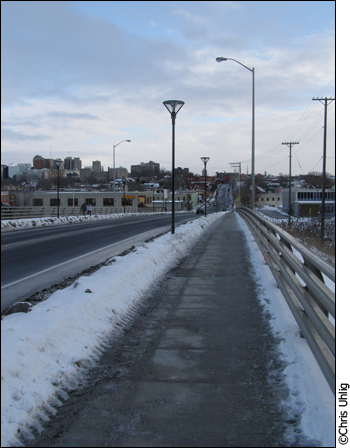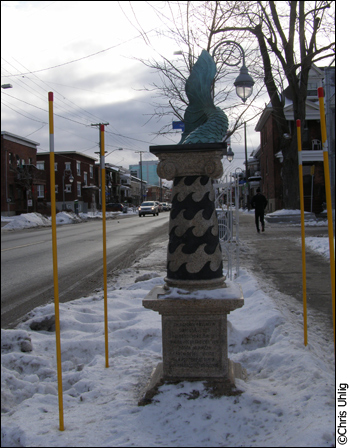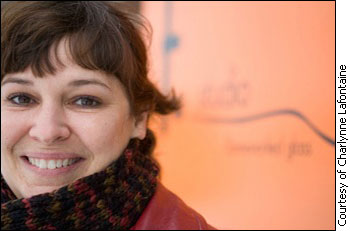Tags
Related Posts
Share This
My fair neighbourhood
On a Sunday afternoon, the construction crews are absent from Somerset Street. Their machines litter the eviscerated asphalt, seemingly abandoned. Despite the silence and stillness, it’s not hard to imagine them in motion. From Booth to Preston, and on to Spadina, the street is hemmed with fences and pylons, piles of gravel and chunks of what used to be pavement. Many Somerset businesses remain open even on this Sunday, but a peek through their windows shows that most are almost empty.

Bad: Machines made a mess of Somerset Street in fall 2011.
The machinery and debris represent Phases Three and Four of the Somerset Street West reconstruction. Phase Three began in summer 2010, and is planned to complete in Summer 2012. Phase Four began in summer 2011, and will likewise complete in summer 2012.
For the time being, the reconstruction is, to put it bluntly, an eyesore. But the street’s ragged edges aren’t going to be permanent; as part of the reconstruction process, the City of Ottawa asked local artists to submit proposals for a public art project to be incorporated into the construction.
This part of the makeover is likely familiar to those who have been to Preston Street or Wellington Street West following their brushes with heavy machinery. Both those neighbourhoods feature public art. For Wellington Street, eighteen marble statues were completed in 2010. For Preston Street, fifteen granite columns called Postcards from the Piazza were completed, also in 2010. Both projects fall under the City of Ottawa’s program allotting one percent of reconstruction-project funds to creating public art.
For the gutted stretch of street on Somerset West, this program means some much-needed beautification. For this particular project, the city also found itself exploring new territory artistically. The call to artists requested that proposals focus around light, and placed emphasis on the use of new media such as video, sound and LED.
‘Public art really has the potential to accelerate the way a community sees itself.’ — artist Ryan Stec
On the street where art lives
Public art has an important role to play in the health of communities. Eric Darwin lives in Ottawa’s west end and writes the blog West Side Action, where he often addresses the Somerset reconstruction. While he has expressed some frustration with the construction process, he is very supportive of the public art program. He says that public art brings art to a more accessible level.
Darwin has attended several open houses for the City’s public art projects, and was in attendance at the October 6 event for Somerset West. Darwin was quite impressed with the entries he saw there, he says.

Better: The bridge on Somerset will have its new, blown-glass light fixtures by summer 2012.
“Art has many functions,” he says. “It brings communication, and brings people out to talk about something.”
Darwin says that the Ottawa west end has been lucky to receive so many public art installations. He adds that such projects are a unique opportunity to give residents and visitors a sense of the neighbourhoods’ history.
“You can really tell the story of the neighbourhood,” he says. “I think it enlivens our street. There’s no reason public spaces have to be dead.”
The one-percent-for-art program has existed since 1985. The program, which is responsible for many recognizable projects around the city, is an important one, says Melissa Ramsden of the city’s Public Art Program. She says that public art projects bring a lot of value to the neighbourhoods they occupy.
“It’s important to give artists a chance to respond to the city in a creative way,” says Ramsden.“It also gives the community access to art, and for some could break down the barriers formed by galleries.”
With a little bit of competition
The call to artists for the Somerset West reconstruction went out in spring 2011, with the deadline for submissions being July 11 of that year. The area designated for the project is the bridge area over the O-train tracks on Somerset, northwest of Preston Street.
The selection process has two stages, according to Ramsden. First comes the submission of proposals; for Somerset West, 16 entries were submitted. This was then narrowed to a shortlist of five artists. The next stage includes an open house, where residents are invited to respond to the shortlisted proposals. The Somerset West open house, on October 6, was attended by around 100 people, says Ramsden.
“The community feedback helps inform the final decision, and it’s a great way for the community to get involved,” she says. Residents who attend the event are invited to write comments, which are passed to the jury, which completes the process by selecting a winner. The jury is composed of local artists, a community representative, a landscape architect, and the planner for the reconstruction project. The projects are judged according to various criteria, including artistic merit and their ability to directly address the site itself through historical or visual references, as well as to look to be engaging to the public.

Best: Preston Street is one of several Ottawa neighbourhoods to have its own art features. Plans are similar for Somerset.
This process has gone largely unchanged since 1985, says Ramsden. She says she considers the process a good one. Darwin also voiced his support of the way that the City incorporates community feedback into the selection process.
Why can’t the City…?
The experience of working with city hall was not ideal for everyone, however. One artist shortlisted for the commission, Ryan Stec, experienced some frustration during the selection process. Stec stresses that he feels the program is an important one and a good effort overall, but he says the City’s approach to incorporating new media into this project created some friction.
The trouble began when Stec’s team’s first several ideas, including use of radio frequencies and interactive lighting to create a unique experience for pedestrians, were rebuffed by the City for being impossible to accommodate. Part of the problem, Stec says, was that the Public Art Program has not worked with new media before.
“It’s not usually a place that can accommodate our art,” he says. “I don’t think the City as a whole is welcoming to our approach.”
Ramsden says that some of the restrictions placed on artists were due to the need to accommodate Hydro Ottawa’s parameters for putting art on hydro poles. Certain standards were set out as a result.
Despite his frustration with the process, Stec emphasizes that the City should keep the program. “The only way for the process to get better is to keep doing it,” he says.
Just you wait
On November 7, 2011, the City of Ottawa announced the winners of the commission for the Somerset West public art project. Charlynne Lafontaine and Ryan Lotecki will be making flame-worked glass sculptures to attach to existing light features.
‘There’s no reason public spaces have to be dead.’ — community activist Eric Darwin
Lafontaine says her experience with the proposal process was very positive. This is her first time designing a public project, and the first commission she has won.
“It feels fantastic; I feel validated,” she says.
She also expressed excitement about working with the City, and said that the application-and-selection process was quite helpful to her: “I appreciated having parameters; it helped to direct my work and keep me focused.”

Part of the makeover team: Charylnne Lafontaine is a sculptor who will be helping to reinvigorate Somerset Street.
The two artists will address the theme of transformation, with glass-blown sculptures of seed pods morphing into flowers from one end of the bridge to the other. Intersections in Chinatown will also receive glassworks as decorations; however, Lafontaine says they have not yet decided on the nature of these decorations.
Despite differing experiences in working with city hall, all of those involved emphasize the importance to communities of public art, and say they feel the public art program is on the right track.
“Public art really has the potential to accelerate the way a community sees itself,” says Stec.
Summer 2012 is the proposed conclusion for the Somerset West of the construction, and hopefully the new face and new artistic features will make the neighbourhood’s hibernation worth it. For the time being, however, Somerset West will have to enjoy its beauty sleep.
Your tax dollars at work
The City of Ottawa invests in arts and culture in several ways aside from its municipal public art program. For example, local artists can apply to the City for project funding, including grants for emerging and established artists of $4,000 and $5,500 respectively.
In 2009, the most recent year for which detailed numbers were available, the City invested $22.4 million in various cultural categories, according to a 2012 Hill Strategies study. Of five major Canadian cities, Ottawa ranked fourth, both in total investment and in per-capita investment.





